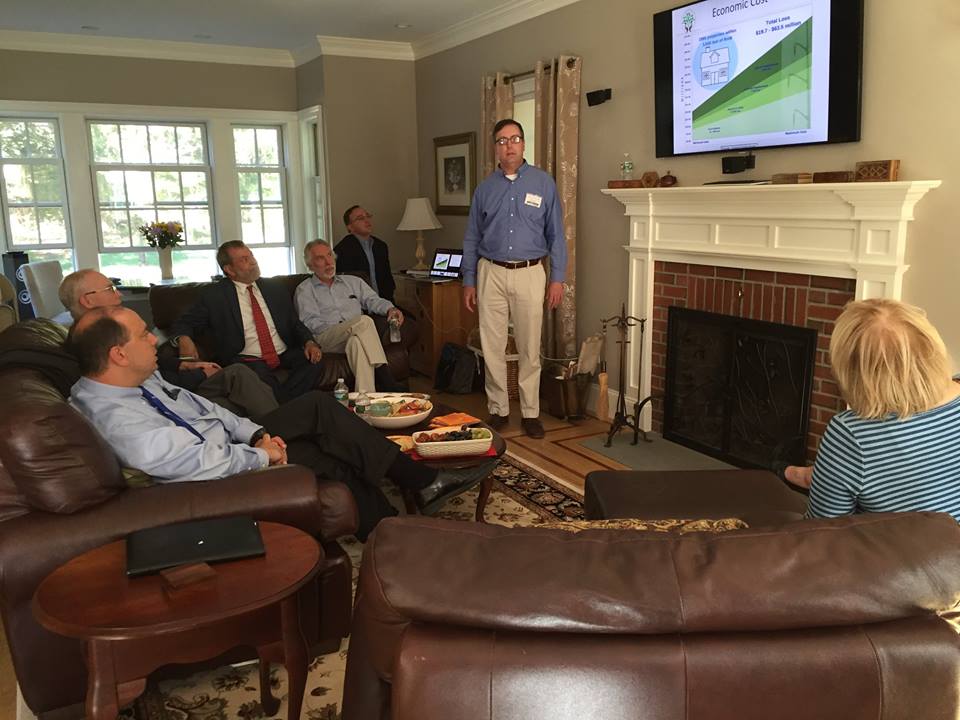Landmark Meeting Of Entire Legislative Delegation In Sudbury:
Escalating Opposition To Eversource Plan, Questioning Need For New Line
On Monday, Sept 12, Protect Sudbury hosted Sen. Mike Barrett, Sen. Jamie Eldridge, Rep. Carmine Gentile, and Governor’s Councillor Marilyn Devaney for a frank discussion of the Eversource Sudbury to Hudson transmission line proposal. Protect Sudbury was represented by Bill Schineller (Government Lead), Jim Gish (Environmental Lead), Chris Hamilton (Legal Lead), Renata Aylward (PR Lead) and joined by resident Nancy Brumback (board member of the League of Women Voters of Sudbury, and Vice-president, advocacy, League of Women Voters of Massachusetts).
Here’s a recap:
Protect Sudbury re-iterated the ‘fatal flaws’ with any MBTA right-of-way (ROW) siting, including significant, permanent, and irreversible environmental and economic impacts. These views are substantiated by many letters of opposition from environmental groups and stakeholders including Mass Audubon, OARS (Organization for the Assabet, Sudbury, and Concord Rivers), US Fish and Wildlife, Friends of the Assabet River National Wildlife Refuge, Sudbury Water District, Sudbury Conservation Commission, Marlborough Conservation Commission, Sudbury Board of Selectmen, Sudbury Town Manager, and private citizens. In response, Sen. Eldridge, Rep. Gentile, and Gov. Councillor Marilyn Devaney affirmed they are STRONGLY against any siting along the MBTA ROW corridor and would prefer an under-street option. Sen. Eldridge is actively working to enlist US Sen. Markey’s help at the federal level.
Sen. Barrett also strongly opposes the all-overhead wire option. However, he encouraged a hybrid option on the MBTA ROW where the line would go underground near residences (which requires a minimum 30 foot clearcut) and overhead elsewhere (82 foot clearcut, 100 foot towers) as a way of mitigating impacts to abutters and while trying to shave construction costs. He asserts that the MBTA ROW route doesn’t directly impact his constituents and that under street options would shift controversy to other residents. He also wants the tree canopy along the rail bed preserved should Sudbury decide to construct a bike path in the future.
Entering our meeting, Sen. Barrett’s opinion of likely outcomes when Eversource goes to the Siting Board was that the overhead route probably won’t get selected, the state could prevent the use of herbicides and require Eversource to minimize the clearcut, to even less than the 30-35 feet Eversource says they need for an underground line on the MBTA ROW (82 feet is what Eversource says would be needed for an overhead line).
Protect Sudbury respectfully believes Sen. Barrett’s points above are wishful thinking, based on historical precedent and our deep understanding of the facts of this proposal.
Protect Sudbury’s opinion of the likely outcome is that, as things stand now with the Eversource proposal, the overhead line option would be selected and Sudbury would suffer devastating environmental and economic consequences.
In support of Protect Sudbury’s opinions, we discussed:
History and guidelines of Siting Board decisions to go with lowest cost
“Localized Cost Allocation” which would make local ratepayers pay the cost difference to bury lines if a cheaper overhead option is on the table
Eversource’s history with herbicide use, and their direct answer to Town counsel that they would not adopt any special protocols in Sudbury – just their standard Integrated Vegetation Management Plan which includes longterm use of herbicides
The details of why Eversource says they need to clearcut more than 30 feet to fit underground lines alongside gravel utility truck access path.
The complexity of MBTA lease concerning ‘rail-banking’
At that point, Senator Barrett conceded if Protect Sudbury’s assessment is in fact accurate, then eliminating the all-overhead option from Eversource’s proposal to the Siting Board would make sense.
We also discussed the fact that ISO-NE selected Eversource’s (then NSTAR) proposal for a new transmission line over a competing bid by National Grid. National Grid’s plan involved no new lines but still would have satisfied the defined reliability need. None of the members of the delegation were particularly aware of the existence of this competing proposal. We discussed our understanding that the ‘no new lines’ National Grid proposal lost to Eversource’s ‘new transmission line’ proposal on the basis of cost, which was about a $10M difference at the time.
This caught all of the legislators’ attention, including Sen. Barrett. All members of the delegation agreed that ISO-NE selection process should be revisited, including an investigation into the defined reliability justification and a second look at the National Grid proposal for NO NEW LINES. The group wondered about Eversource’s motivation for a new transmission line and suggested money may be a factor.
In light of the process that got us to this point, the delegates discussed working on legislation to fix the Siting Board process, to address the use of herbicides, and how to address the decision-making process at the FERC/ISO-NE level.
Protect Sudbury summarized key points including:
– The National Grid solution involving no new lines would be best
– Under Street/utility routes are superior to the MBTA ROW
– Eversource still has not eliminated the option with the most egregious, obvious flaws
– Likeliest outcome of Eversource’s latest proposal is that an overhead line will be selected on low cost basis and Sudbury will suffer unnecessary environmental and economic impacts
But be assured: Protect Sudbury won’t leave the fate of our town to chance! We think it is fair to question the fundamental need for a new line, in light of National Grid’s solution involving no new lines.

